Freemarket by Echophonic
Introduction
Original SA post
We are a society of functionally immortal, cybernetically modified, telepathic infovores.
You are now one of us.
Welcome!
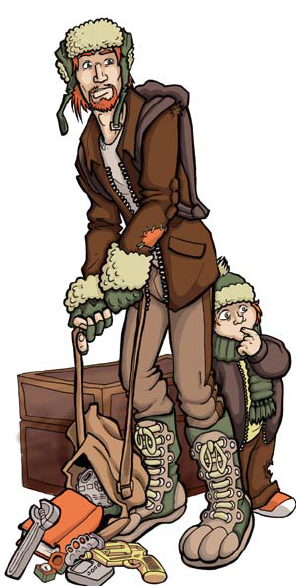
 Introduction
Introduction
FreeMarket is a game by Luke Crane (Burning Wheel) and Jared Sorensen (Lacuna Pt.1, InSpectres, Parsely) that came out in 2010. It’s a transhuman scifi game that does away with a lot of the existential issues and tosses the kinds of scarcity that normally drive RPGs out of the window. You can find out a little more (or buy it!) on the website for the game, Project Donut .
 Life on FreeMarket
Life on FreeMarket
Genetic modification and cybernetics are ubiquitous on FreeMarket and very few people opt out of being redubbed (having your memories put back into a new body) on perfect death (which is pretty uncommon, anyway). It takes place on the CHOIRS station, rechristened FreeMarket ages ago. There are no laws to speak of, but they think they’re doing a pretty good job, since there’s no crime to speak of and no permanent death. Being deathed is an inconvenience, at worst, since all you really lose is short-term memories and some recovery time in severe cases. We'll talk more about death and deathing when we get to talking about the Wetwork experience type.
What drives this is a social system and currency called Flow. Effectively, it’s Reddit karma if you needed to spend it to do stuff, for lack of a better example. You gain Flow by making friends and improving things on the station. You invest it when you try to make changes or make new things; getting some back if you are efficient about it. You can also be voted off the station if you overextend your Flow. Gaining and spending Flow in Challenges is the core mechanic of the game, which I’m looking forward to going over.
People on the station tend to congregate in groups called MCRZs (descendents of the Original’s Multi-Cultral Regional Zones), which is pronounced ‘mercies.’ These groups each have Flow of their own and work together for a specific purpose. These are core to the adhocracy that allows FreeMarket to work the way it does.
People all have a piece of tech embedded in their heads called a Key. This is your scifi personal computer. It allows you to track friends, look things up, and keep you connected to the Aggregate.
The Aggregate is the massive neural net that runs FreeMarket. It’s not known for its personality, but it responds to the needs of the station residents well. Imagine Paranoia’s computer, but actually as helpful and friendly as it thinks it is.
 Player and Character Terms
Player and Character Terms
FreeMarket uses two pretty straightforward computer terms for players and GMs. Players are known as Users and the GM is the Superuser .
To give you a feel for how jargon-heavy this game can be, here’s a quick list of some of the more important background terms. I’ll be defining other jargon as we go, as character generation is rife with it.
 Jargon
Jargon
Adhocracy – Originally coined by Alvin Toffler, the basic idea is that tasks are completed by non-centralized groups instead of a central authority. MCRZs are how FreeMarket does this.
Aggregate – The computer systems that automate life on the station. An actually competent version of Paranoia’s computer.
CHOIRS – The Cassini-Huygens Orbital Intrasystem Relay Station. This is the original name for FreeMarket. It calls out the original purpose of the station. This is acting as a data relay for backup information being sent to Tethys, one of Saturn’s moons, which was converted into solid-state storage for the entire human race.
Donut – Nickname for the station. Something like The Big Apple for NYC.
Flow – The social currency of FreeMarket. The game is based around spending and earning this, since it’s the only way to get access to more resources. Measures how influential and popular you are. It’s primarily gained through making things better around the station and making friends. You can also earn more by doing things efficiently.
Interface – Anything that is installed into a character. This can include cybernetics, software for your Key, and anything else that makes you more than human.
Key – The interface that keeps you linked to the station. It’s how you’re tracked by friends and the Aggregate. Basically your smartphone if it was literally attached to your brain, instead of figuratively.
Meme – Most internet users are familiar with this term, it being a unit of culture that is spread person to person.
Squirt – To send data using your Key to something else, including other people’s Keys.
===========
So there we go, your FreeMarket primer.
Next time : Characters! Edgy, cool space farmers! MORE JARGON!
A Tour of Freemarket Station
Original SA post

Alright, so I realized I missed something from the first chapter: Some extra background on the station! We'll talk about character generation next time, I promise.
A Tour of FreeMarket Station
FreeMarket Station is a classic space station type, the Stanford Torus . Nothing too fancy here, the station is the classic 'wheel' style torus, which in this case is eight-spoked and three and a half kilometers across. The hub is zero-gravity, as you'd expect, and is used for engineering and research. It's known as the Hole.
Light is provided by a massive mirror, refracting light into the rim of the wheel. This is attached to the hub, as is the massive communications array. The entire station is surrounded by a wall of lunar concrete to protect against space stuff like radiation and bigass rocks.
It has gravity somewhere near Earth's, created by the rotation, but it decreases the closer you get to the Hole. Light, as mentioned above is refracted by a giant mirror through quartz-glass windows. You usual terms for direction aren't useful, so spin and anti-spin are used.
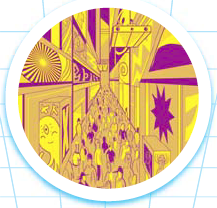
The station has over 80,000 people on it, despite being designed for 10,000. Advances in technology and efficiency pushed this to 40,000, then to the current population of 83,679. The original station was designed to be more spread out and focused on agriculture, but became more and more urban as time went on.
Architectural styles are all over the place, mostly based on the person building. Classic Earth styles blend with the hyper-modern, turning the station into a bit of a chaotic cluster at times.
This is also where I think some criticisms of the libertarian bent of this game will fall in. The largest buildings are controlled by the most influential MRCZs (since space tends to be at a premium and these guys use it the most effectively) and are made of some of the most advanced materials, whereas some folks live in scrap metal domes. It's all about who you are and what you're doing for/with the station.
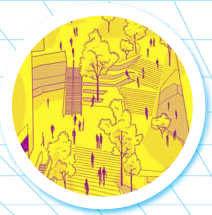
There's really only one rule on the station: You can ask to leave whenever you'd like. You aren't allowed back, however. It's like All Dogs Go to Heaven, but with fewer clocks. A lot of folks have trouble adjusting initially, but most people stick around and do alright for themselves.
Now, we know the station's full of matter-printers and people can make animals and robots. What you can't do is put a human consciousness in one of those. It's messed up, to start, and secondly, it doesn't even work. Just drives the person insane. It's mentioned that it's considered tantamount to murder and cruel to the animal. The only REAL issue with this isn't legal, it's social. Don't be cruel to animals or you'll get a Frownie (a 'screw you' Flow hit people can give you) for being a douche.
Ah, libertarianism. I do like the implicit 'no, you can't be a cat-man, fuck off' here. Nothing stopping you from having mobbed cat ears as an interface, though.
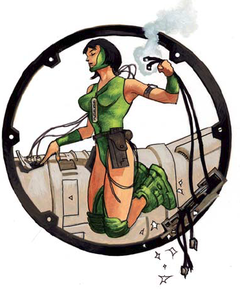
Playing FreeMarket
FreeMarket isn't very different in play than most other tabletop RPGs. Superusers walk Users through making characters, the Users make an MRCZ so they can advance their goals. First sessions should include a sample Challenge (which we'll cover later, it's the second longest chapter in the book, after the Superuser section) to make sure everyone gets how they work, since they're kind of odd. Challenges are card-driven, with actions and points available based on what sorts of things your character has access to becoming involved.
Throughout the book, Luke and Jared play a session. They are done in little bubbles and I'll include relevant bits and pieces as we go.
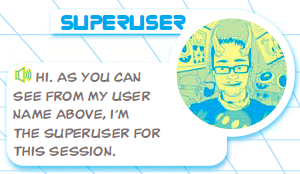
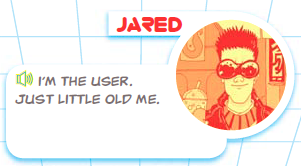
Next time:
Actually doing character generation next time! We'll save the thread-based character until after we talk about Experiences, though.
Who Are We?
Original SA post

You can be anything you want on FreeMarket. Except a robot or animal, that's a good way to end up insane.
Anyway, let's see how we make characters! The character and MRCZ can be found over at Project Donut .
Who Are We?
There are 11 core pieces of your character sheet:
Key ID
This is your handle aboard the station and how you show up to the Aggregate. Your character's name, basically.
User Name
This is your, the player's, name.
Clade
This is your overall character concept. Think a Defining Aspect in a FATE game. It's who you are and what you want to do. The Generations have an example character each, they can be found along with the character sheets on Project Donut.
Generation
One of the more interesting items for me. You can play as a First Generation, a 2nd Gen, a Blank, or an Immigrant. These determine a lot of your starting values, so the choice will both drive roleplaying and affect how you interact with the mechanics.
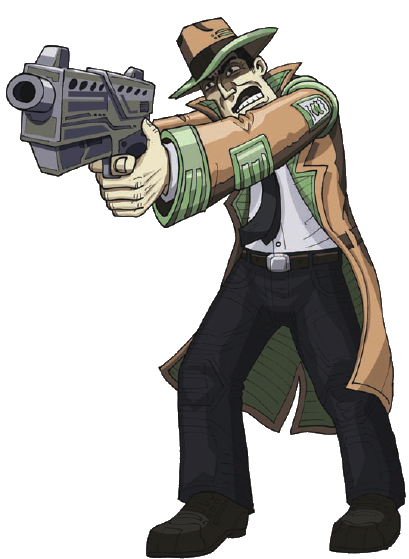
Ellroy Leonard, First Generation, Clade: Hardboiled Operatior
First Generation Freemers are the children of the Originals, the people who designed and built the station. This generation uses less extensive modification, but knows the station's technology well. First Generation names are more 'normal', being traditional Earth names. This doesn't stop cultural mixing, though, meaning you'd see European genelines with Asian or Arabic names.
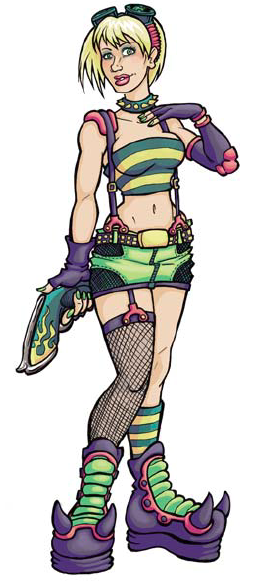
Betty Holly, 2nd Gen, Clade: Punk Rock Rollergirl
The 2nd Gen are really the first true natives of the station, they don't know anything else. They know the station's culture best, have the most experience living and interacting on the station and tend towards heavier modification, both cybernetic and genetic. 2nd Genner names tend to be more out there. They're more like internet handles than anything, with some of the examples being Interrobang (after the Aggregate rejected "?!"), Chromedome, Opal, and, my favorite, Stan! (with the exclamation point).
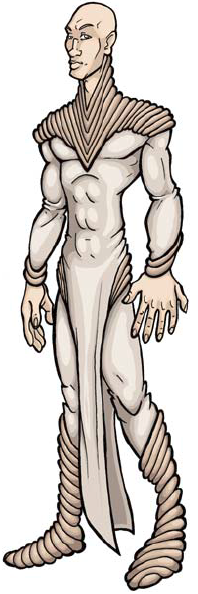
Qais Bruin, Blank, Clade: Zen Physicist
Blanks are created humans, built by matter printers and have memories and experiences loaded into them. They were initally treated as a novelty, but eventually people realized they were just as human as anyone else. They're pretty well-balanced as a result. Blank names originally were alphanumerics like Mark-5, but now they're named by their adopted 'parent', meaning names will be like that generation's.

Sensar Khenbish, Immigrant, Clade: Martian Refugee
Immigrant covers anyone not native to the station, and are thus not technically a generation. They tend to be few and far between, due to how few immigrants FreeMarket can support. Only 2.66% (Yay, number porn!) actually last the first week, mostly lending to culture shock and asking to leave. Immigrant names can be anything you'd find on Earth, but a lot of the outer colonies have large populations from the Middle East and the Indian sub-continent's descendents, so the names are primarily Urdu, Hindi, and Punjabi in origin. They bring new memes and technology to the station, leading to them being very strong with tech and lightly modified, if at all.
Geneline
Genelines represent your genetics, representing natural talents and genetic modifications. It's a number, determined by your Generation, that represents how many times you can use it in Challenges. It also has tags, which we'll talk about during character generation.
Experience
These are your skills, effectively. You start with an amount of points ,determined by your Generation again, to distribute among 14 skills. You don't get a lot, but focusing makes you better and you can learn new skills as you go.
The Experiences are:
-
Breaking, which is your hacking skill.
-
Cultivation, which covers making old-world goods. Handmade stuff, growing things, that sort of thing.
-
Ephemera, which relates to art and ideas. Creates short-term memories.
-
Flood/Bleeding, which is memory hacking. Alters and creates long-term memories.
-
Ghosting, your all-purpose stealth skill.
-
Mobbing, standing for Modifcation Of Body, this is the cybernetics skill.
-
Negotiation. Hopefully this one is self-explanatory.
-
Printing, which is how to use matter printers to build things.
-
Recycling, which is repairing tech or making new tech with the remnants of the old.
-
Shaping, your physical manipulation skill.
-
Social Engineering, your verbal manipulation skill.
-
Switching, this is the one that lets you hack the
GibsonAggregate and fake your identity.
-
Thin Slicing, which is your decision-making and Google-fu. Cutting through the flood of data and other input to get the info you need or decide if someone's giving you accurate info. Hell, you can even use it to figure out if something's cool or not.
-
Wetwork, your all-purpose violence skill. Takes people out of play temporarily.
Interface
Interfaces cover the implanted tech you use. Your Key is a primary example, but people have all sorts and it's mostly to cover your gaps with information and error-correction, making life easier.
Tech
Tech is more the external objects that get used, things you can use, break, and trade. Guns, goggles, pets, and software that runs on your interfaces all count as Tech.
Memories
Memories are how you track the sorts of things you've done and who you are. As noted above, though, you can have your memories hacked. This is the closest you get to any of the usual existential issues this game addresses. It's pretty flippant about having unique memories stolen or damaged, though.
Flow
We've talked about this earlier a bit, but this is your social currency. You make it by makign friends and helping folks or otherwise contributing to the station and lose it by being a drain on the station. You need this to enter Challenges and earn it back through roleplaying and the outcomes of Challenges.
MRCZ
Your MCRZ is the group you're a part of. It's recommended that players share one, from what I can tell, but there's nothing stopping everyone from being part of different ones. This may even come up through play!
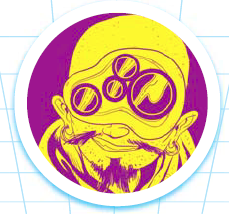
Becoming One of Us
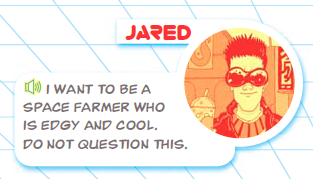
We'll follow along with Jared's sample character creation, based on this picture. Character generation isn't too complicated numerically, but it's very much creativity-driven. It's like FATE in a way, with almost everything having tags, but you want simpler here. I tend to have a hard time with Aspects, so this is a little easier to me, at least after reading it.
You start, as per usual, with your concept. In this case, your Clade covers that. Jared wants a space farmer, so he writes down Precocious Space Farmer here. Other examples are Ex-Martian Philosopher, Wall-Crawling Ninja Hacker, and Noir Detective.
Next, you pick your Generation. This determines how many points of Geneline, Experience, Interface, and Tech you start with. Blanks have the strongest Geneline rating, 2nd Gen have the most Experience (though First Generations are close), Blanks have the most Interface, and Immigrants the most Tech (with First Generations close again). It's all based on what you want to do. Jared's character is a 2nd Gen , so he gets 2 Geneline, 5 Experience, 2 Interface and 1 Tech.
After that is designing your Geneline. Genelines have a name, rating (based on Generation), and three Tags. Names should describe the line somehow. Jared goes with Appleseeder (at rating 2, from above) and the tags Green Thumb, Common Sense, and Plucky .
Following that, you get to mark out your Experiences. I covered these earlier, so let's skip to Jared's picks. He gets 5 points and takes Cultivation 2, Recycling 1 and Shaping 2 .
After Experiences you move on to Interfaces. Interfaces are the things that make you more than human, the biomechanical tools that help you work in the station. Interfaces have 3 tags, like Genelines, but one HAS to be an Experience. Why would you get something implanted if it didn't help you do stuff, anyway? The tags an Interface has determines if it can be applied to a challenge. Jared goes for something normal and something odd with his 2 points. He goes with two 1-point Interfaces, but could have had one 2-point Interface. His first item is the Agronomist's Database and his second is vegetation-based photosynthetic hair.
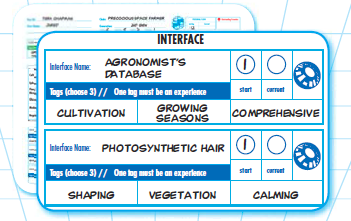
Tech is next up. It's all the external stuff you use. Like Interfaces, Tech has 3 tags with one being an Experience. Jared gets 1 point. This point goes into The Germinator, a mechanical gnome.
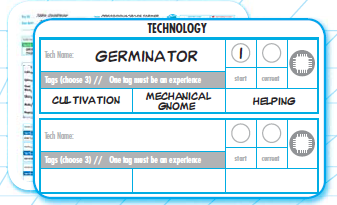
That completes most of the mechanical stuff about your character. But there's a few things remaining. These are your MRCZ, your Memories, your Flow, and your Key ID.
MRCZs have a name, a purpose, three tags, needs, a tier, and flow. There's a profile sheet for these. Jared's MRCZ is the Garden Party. Flow is determined later, since MRCZ flow is determined by tags and members.
Garden Party, Tier 1 MRCZ
Purpose: To supply fresh produce to FreeMarket
Tags: Cultivation, Produce, and Gigantic
Needs: Tech, Land, Members
Memories are the most valuable commodity on the station. Players start with two long-term and one short-term memory. We'll talk about what these are used for (much) later. They're ideally made up of three concepts from a list of five. These concepts are a person, a group (or MRCZ), a place, an object, or an action. Jared's long-term memories are of him helping his mother can peaches from an aeroponic orchard and the time Rafe from the Missing Foundation MRCZ decompiled his garden with a robotic groundhog. His short term memory is of talking to to the historian Lenin Merengue about the original Garden Party.
Flow is pretty easy to start. Each Generation has a base value. You get one extra point each if you have cultivation, mobbing, negotiation, printing, recycling or thin slicing as Experiences and another point for each Interface or Tech you have that is tagged with one of those. Jared starts with 12 flow, 8 from being 2nd Gen, 2 from having cultivation and recycling and 1 point each for his tech and interface that have those. He gets no points from his photosynthetic hair, since shaping isn't a skill that grants extra flow.
MRCZ flow is a little different. It starts at the lowest flow of its founders, with a varying bonus for Experiences it has tagged. Since the new Garden Party only has Jared's character, it starts with 12 plus a 2 point bonus for Cultivation. Negotiation, Recycling, and Thin Slicing give 3; Cultivation, Mobbing, and Printing give 2; all other Experiences give 1. Other tags don't give anything.
Finally, you name your character, giving them their Key ID and an identity on the station. Jared chooses Tera Chapman for his character.
Here's Tera's final sheet. Click for big.
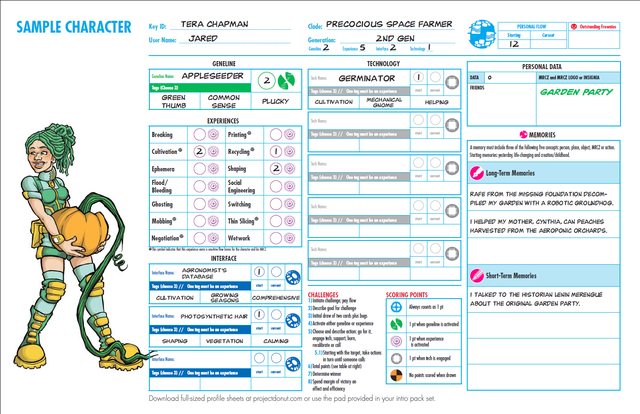
Next time!
If anyone's interested in pitching a character, feel free and we can try making one or two. It shouldn't be too hard! It'll also help fill the time while I work on the Challenges chapter. It's not complicated, but it's kind of neat and I want to do it justice.